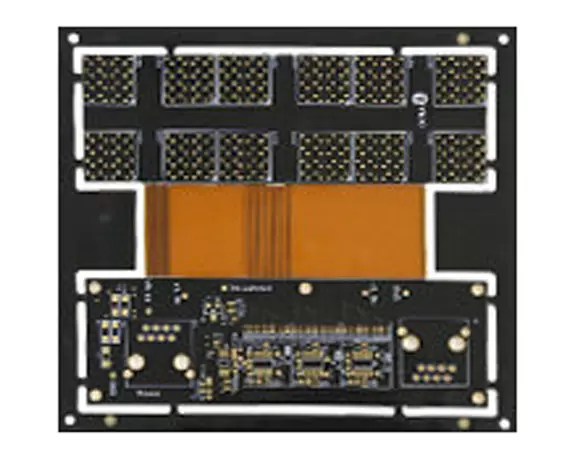 Integrated rigid sections with flexible tails for compact layouts
Integrated rigid sections with flexible tails for compact layouts
 Vibration-resistant and reduces the need for connectors
Vibration-resistant and reduces the need for connectors
 Simplifies assembly and improves long-term reliability
Simplifies assembly and improves long-term reliability
 Enables 3D configurations for space-constrained applications
Enables 3D configurations for space-constrained applications
 Used in aerospace, medical implants and premium wearables
Used in aerospace, medical implants and premium wearables

| Feature | Technical specification |
| Number of layers | 4 – 60 layers |
| Bending performance | Based on the specific design, the bend performance can range from a basic 90 bend to fit to a full dynamic flex with 360 range of motion in the flex tail that will withstand continuous cycles throughout the product life |
| Bend features | Bend radius controls the flexibility of the flex portion of the board. The thinner the material the lower the bend radius and the more flexible the flex section |
| Materials | RA copper, HTE copper, FR-4, polyimide, adhesive |
| Copper weights (finished) | 0.5 OZ – 6 OZ |
| PCB thickness | 0.40 mm – 6.0 mm |
| PCB thickness in flex section | 0.05mm x 0.8mm |
| Max. dimensions | 620 mm x 720 mm |
| Min. track and gap | 0.075 mm / 0.075 mm |
| Min. mechanical drill | 0.15 mm |
| Surface finishes available | HASL (SnPb), LF HASL (SnNiCu), OSP, ENIG, Immersion Tin, Immersion Silver, Electrolytic gold, Gold fingers |
![]()
Engineering Support
![]()
Prototyping Services
![]()
Fast Turnaround
![]()
Seamless Transition to Mass Production
 What is the production process for a rigid-flex PCB like?
What is the production process for a rigid-flex PCB like?  What industries commonly use rigid-flex PCBs?
What industries commonly use rigid-flex PCBs?  What are the benefits of using a rigid-flex PCB?
What are the benefits of using a rigid-flex PCB?  How does a rigid-flex PCB differ from a standard PCB?
How does a rigid-flex PCB differ from a standard PCB?  What is a rigid-flex PCB?
What is a rigid-flex PCB?  Do rigid-flex PCBs have special quality requirements?
Do rigid-flex PCBs have special quality requirements? Yes. They need strict bend tests, good material control, and careful inspection to avoid cracks or layer separation during use.

Customer support